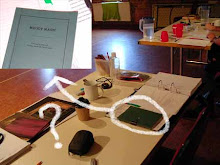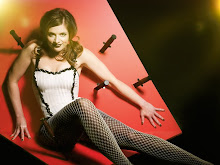
Yesterday’s photograph; you’re probably wondering what that was about. Well, there’s a book that has been published for the show. It’s called “Muddy Magic” and I’ve been told there’s only 4 copies in the world. What’s more, access is extremely limited. More on that when nobody’s around and I can sneak a peak at it.
Days begin and end with singing; first thing and last thing. I asked Chris to comment on that;
“Singing around the piano is a great way to set the atmosphere for the day, and the perfect tool for building the ensemble, and helping them to get into each other’s rhythms.” (despite the quotation marks, that’s not actually a direct quote. You can ask New Weekly how that goes.)
Early in the day we were treated to one of Matt’s signature circus acts. We were talking about circus yesterday in the script discussion. It was mentioned that circus acts are so appealing because we see the performers doing things that shouldn’t be possible. It’s an expression of optimism and inspiration because it cracks the limitations we think constrict our lives. Matt was performing the act so the designers could judge whether it would fit in the confines of the set. While he was performing it there were jokes and commentary until a very specific moment. At that moment the act tipped over into what everybody felt was dangerous territory, and as one, everybody in the room fell silent. The power to spellbind a crowd; now that’s power for an actor.
The morning carried on with the script from where we left off yesterday. We moved on to the first big group scene. So many different things to work on all at once in this scene! The first big group scene is an establishing scene in many ways; spatially, in narrative, character construction, character relationships, tone, atmosphere, rhythm...the list is endless.
The process is one of ‘feeling’- Chris, Mark on piano, and the cast ‘feel’ their way into the world of the play. Everybody works through the scene making tentative offers of all kinds. There are subtle exchanges between everybody in the room. Chris encourages the performers to explore the ‘stuff’ of their characters when they aren’t the focus of the scene. He carefully insists that everything is available to change. It’s not a process of decision making. The group makes a series of offers that combined begin to define a sense of the world, while at the same time they feel their way through what the script is guiding them to do.
You get the sense that the greatest progress being made is perhaps not to the scene itself. The progress is in the slow definition of their world.
The first part of the afternoon is dedicated to working on Maude & Doris, the character played by Christen, and her ventriloquist’s dummy. Christen is not an experienced ventriloquist, and the process of learning to work with the dummy is wonderful and fascinating. Seems like something that could serve as valuable actor training in the same way that mask work is a part of many training courses. She is creating two characters who are the same person, using different tools for each. It seemed to me as I was watching that the kind of technical, practical questions that are necessarily asked of the dummy could quite often elucidate things for a 'human' character. I’ll try to talk with Christen about this when an opportunity presents itself.
I snuck a couple of questions to Richard, the lighting designer, as we watched the rehearsal. I asked him what he was most looking for at this stage of the process. His response was,
“Physical blocking, tone of the piece, feel of the world…”
And what does he see as his biggest questions to answer at this stage? He had two responses;
“I need to know more information about the set,” was his response. The shape and intent of what will be built is clear from the design presentation, but some set elements have a lot of detail that won’t be totally understood until it’s been built. This is an ongoing issue for professional theatre-makers. How do the artists develop a relationship with their physical world if they can’t interact with it?
And,
“How am I going to tackle the third act?” Yeah, the imaginative demands are massive for the third act. This is one of the big design/direction questions of the play.
Finally, I asked Richard how much of his work is technical/practical and how much is interpretative/creative. He said it is about 50/50.
Darren’s word for the morning – blocking
Darren’s word for the afternoon - cut
Richard’s word for the morning – entertaining
Stephen’s word for the morning – spread
Chris's word for the day - door




No comments:
Post a Comment